#madagascar hissing cockroach nymph
Explore tagged Tumblr posts
Text
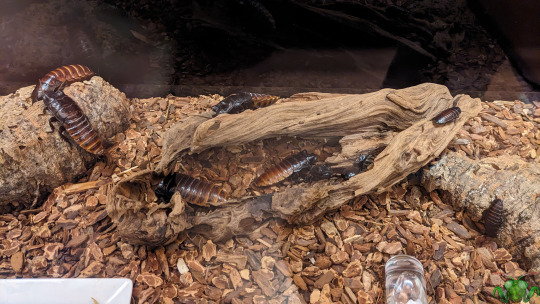
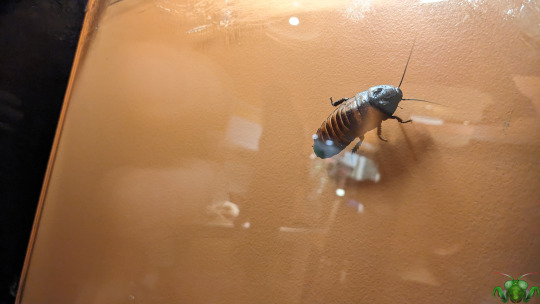
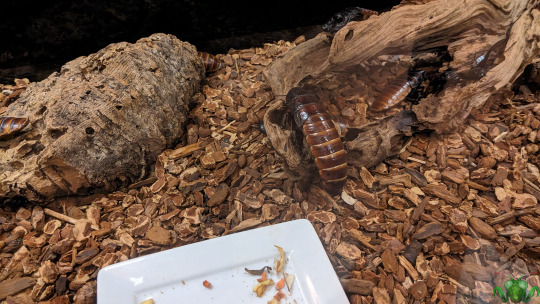
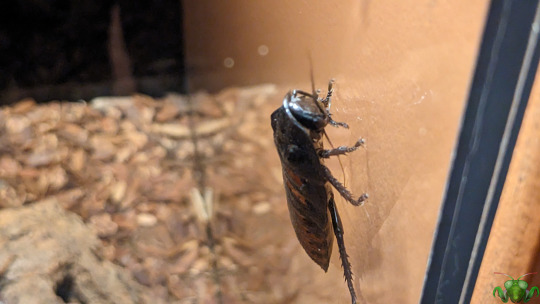
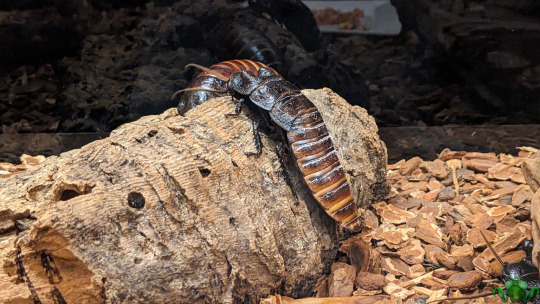
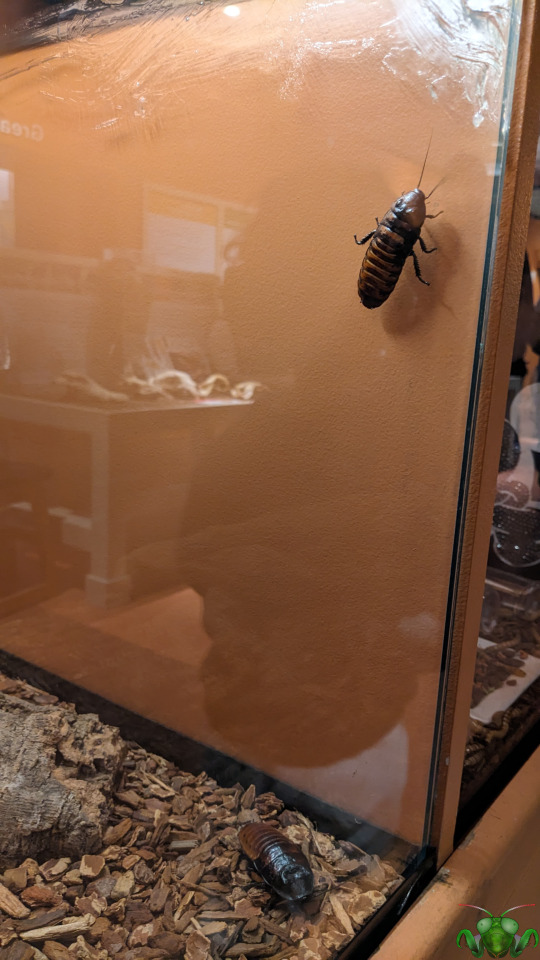
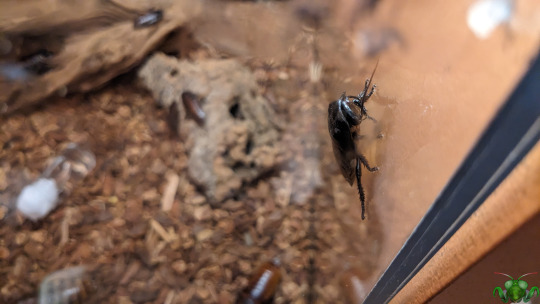
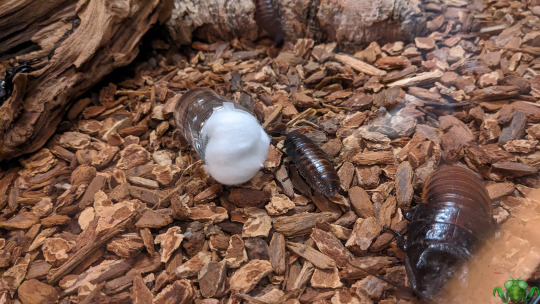
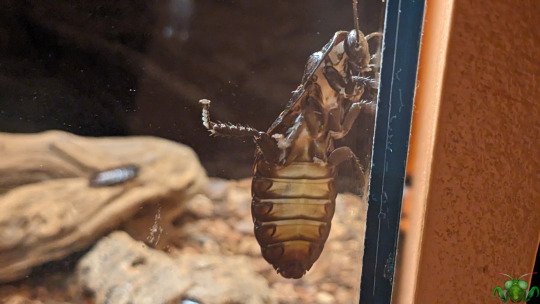
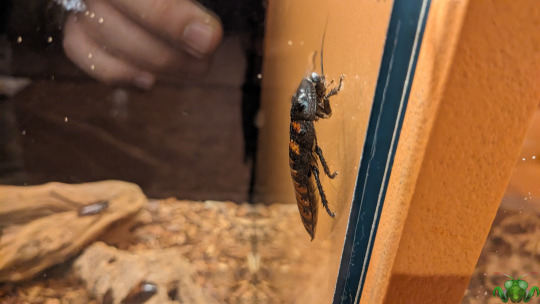
Madagascar Hissing Cockroach - Gromphadorhina portentosa
They're back!
Despite how many postings I've made about the ROM's insects (and this specie's exhibit in particular), there's always something new to talk about or share. For today, I could be wrong, but I'm fairly certain that this insect home is now longer, essentially taking up the space of 2 live-insect exhibits. That's quite an upgrade from when I saw them last year! It's for the best that these Roaches received a terrarium upgrade given that not only are many individuals sharing real estate area, but there are many nymphs scurrying about. A Hissing Roach nymph looks very similar to the full-grown adult, especially since all stages lack wings. However, you can tell them apart as nymphs are smaller in size and leg-span, and their exoskeleton may have a lighter coloration with thinner armor. Inside their exhibit, they have access to good nutrition and protection from predators, so naturally they will molt and grow larger over time. This is good for individual longevity, but if the Roaches cluster, it could instigate competition for space in the terrarium! Particularly among the hardy, fully grown males. Speaking of, there's one specific "handsome" specimen highlighted in Picture 4 (and a total of 3 large males in Picture 1) with a robust form and prominent horns. He would easily batter his rivals, but more room may allow him some peace, so long as other males keep their distance. While the "handsome" males are certainly eye-catching given their large size and pronotum knobs, the showstopper today is a young male.
Although his horns are little more than exoskeletal bumps, the young nymph showcased a lot of promise and strength with his remarkable ability to climb the side of his terrarium. Despite the surface being vertical, his tarsal claws have a strong grip, allowing him to scale up the wall with ease and then move to the right. How he gets down from there is anyone's guess. Moreover, as he moved to the right, his feet were faced with a new obstacle for his climb: glass. While the images capture the beginning of the moment, they don't fully demonstrate just how much effort this insect put into gripping the glass. As the young male stretched out his limbs, the tarsal claws slipped and slid until they found a spot to grip. Like a mountain climber without a line trying to find a foothold, the young Roach was very diligent and careful. He did eventually manage to put more legs on the glass, but couldn't move further to his right very much, so he turned back around to the textured wall. It's still an impressive feat, and it allowed patrons of the museum to receive a good long look at his underside (Picture 9). You can even see his "neck" which is normally concealed beneath his pronotum! It's utterly remarkable how different they look on their underside. Not to mention how fine the sensory hairs along their legs are.
Pictures were taken on November 19, 2024 with a Google Pixel 4. Come and see the many insect exhibits of the Royal Ontario Museum if you happen to be in town. There will be a video follow-up to this point in the future to showcase how the nymphs move and interact with their terrarium roommates.
#jonny’s insect catalogue#ontario insect#roach#madagascar hissing cockroach#cockroach#madagascar hissing cockroach nymph#blattodea#insect#ROM insect#royal ontario museum#insect exhibit#toronto#november2024#2024#nature#entomology#arthropods#invertebrates#photography#animals
18 notes
·
View notes
Photo
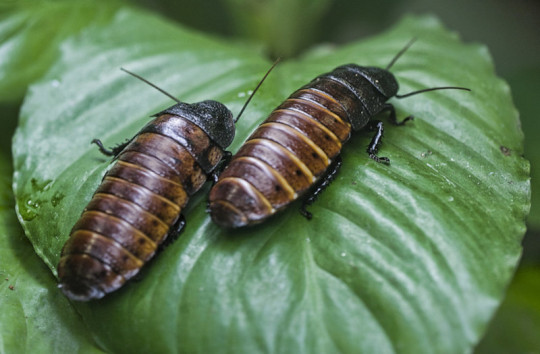
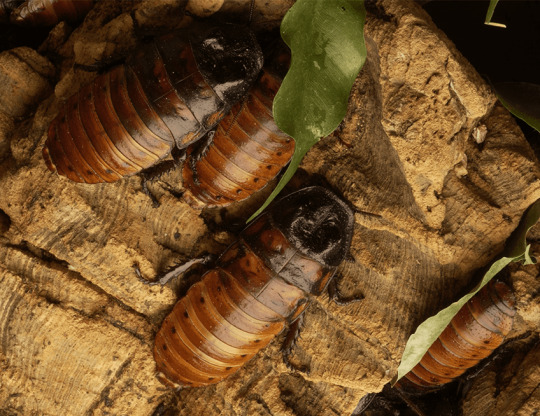
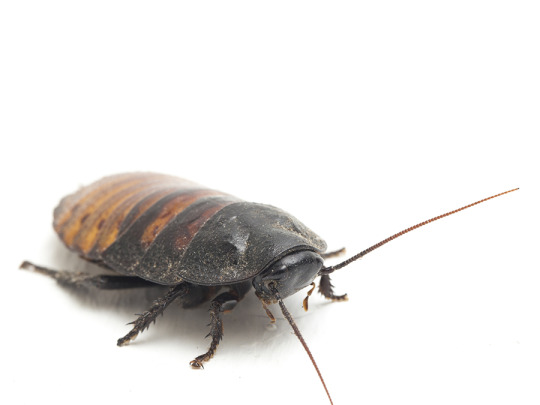
Cozy Up to the Madagascar Hissing Cockroach
One of twenty hissing cockroach species, the Madagascar hissing cockroach or simply the hisser (Gromphadorhina portentosa) is found only on the island of Madagascar. There, it prefers the dry leaf litter and rotting logs of lowland tropical rainforests, though it can also be found in cool, damp, dark areas of buildings. These habitats are ideal as they can offer both refuge from predators like rodents and birds, and food: hissing cockroaches are detritovores, feeding exclusively on decaying plant and animal matter. This makes them important members of the ecosystem as they recycle nutrients back into the soil.
G. portentosa is one of the largest species of cockroach in the world, reaching up to 7 cm (3 in) and 24 g (0.8 oz) when fully grown. Unlike other cockroaches, the hisser lacks wings and travels exclusively over the ground. Fortunately their hard, dark brown exoskeleton provides excellent camoflage against the forest floor. Males and females are nearly identical; the only difference is the pair of horns, or pronatal humps, found just behind the male’s head.
Though they may live in close quarters, madagascar hissing cockroaches are largely individualistic. Males fiercely guard small territories, only leaving occasionally to find food and water. Females and young are somewhat more social, and move in and out of these territories freely. As their name implies, hissers communicate primarily by hissing. This sound is produced by expelling air through their bodies. Four distinct hisses have been identified, each with different meanings; territorial displays, mating calls, and an alarm hiss to warn away predators.
Hissers reproduce all year round, provided the weather is warm enough. Males attract females by hissing loudly, and fight off rival males through hissing competitions and posturing. When a female enters a male’s territory, she emits a chemical to attract a mate. When the pair meet, they enter a brief courtship ritual involving vocalizations and touching each other’s antennae; they then position themselves end to end and remain there for upwards of 30 minutes.
The female will carry her fertilized egg case, or ootheca, for about two months. Up to 40 nymphs will hatch from the case while still inside their mother, who then expells her young all at once. These nymphs resemble adults in structure, but are smaller and lack reproductive organs. Initially they are white, but quickly turn brown or black as they grow, molting about once a month until fully grown. Sexual maturity is reached at about seven months of age, but individuals can live for up to 5 years.
Conservation status: The Madagascar hissing cockroach has not been evaluated by the IUCN, and populations are considered to be stable. In addition, many zoos and private collectors maintain hissing cockroaches for display or food for other animals, as the species is low maintenence and easy to breed in captivity.
If you like what I do, consider leaving a tip or buying me a ko-fi!
Photos
Liz West
Lincoln Park Zoo
Alexandria Zoo
#madagascar hissing cockroach#Blattodea#Blaberidae#hissing cockroaches#cockroaches#insects#arthropods#tropical forests#tropical forest arthropods#tropical rainforests#tropical rainforest arthropods#africa#madagascar#biology#zoology#animal facts
183 notes
·
View notes
Text
My new colony of critters
Madagascar hissing cockroaches (I know they are roaches but be nice)

I got a colony of 20+ nymphs and the lady I bought them from was so happy someone was interested in her roaches.
The biggest one has a lot of orange in it and I love the colors, I've watched a lot of stuff about these beforehand so I know they get huge and these are tiny but it's the biggest of my tiny guys


I'm excited to raise and breed these, these are pets but when they breed I will feed some of the offspring to my other animals


Once they get bigger and start reaching sub adult to adult size I plan to put them in just one 6.5 gallon tank but if they are to crowded I can split them into two 6.5 gallons or buy a 10 gallon.
Very excited to raise these guys!
1 note
·
View note
Text
Thank you for the image description! 2. Is various ages of nymph dubia roaches with an adult male Madagascar hissing cockroach living with them due to social issues in the MGHC tank. And 3. Is another adult MGHC in a different tank!
Gave the kids some apples today :)
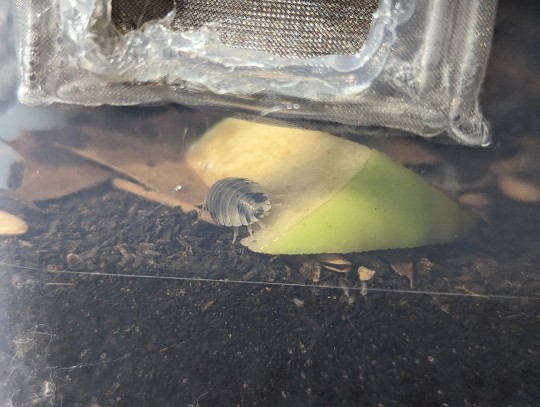





15 notes
·
View notes
Photo


Hippo molted last week and she is now a Big Round Potato who was more than happy to show off her new ability to hiss
#bugblr#cockroaches#madagascar hissing cockroaches#gromphadorhina portentosa#insects#arthropods#personal#i totally thought hippo was male but i can see her underbelly plates better now and its just the 1 round end of a female#it's rly funny to me how literally all my pets turn out female#i have never had any male pets.....dogs. cats. horses. millipedes. now roaches. all ladies#if the other 2 nymphs are female too (which I hope bc otherwise I gotta separate them) then I'm gonna call them the powerpuff girls#my bugs
6 notes
·
View notes
Text
I've been making posts about my spiders but keeping them efficiently requires from me to maintain some different "pets" as well.
Somehow I never posted anything about those... Wonder why...
Here they are:
Shelfordella lateralis, Turkistan roaches, "Turks" or Red Runners:

Those are the smallest feeders I usually need - the nymphs are about 3mm and adults barely reach 3cm. They're good feeders for small and medium spiders, move a lot and are pretty much harmless. They're not a decent meal for larger spiders however.
Blaptica dubia, Argentinian roach or Dubia roach:

The go-to choice when feeding larger spiders. They reach about 5cm and are considerably fatter than the runners. The only issue is - they're not as fast moving and tend to play dead.
Gromphadorhina portentosa, Madagascar hissing cockroach or Hisser for short.

The largest roaches I use as feeders only occasionally. They're massive and have very hard exoskeleton so only the largest spiders can take them and aren't always eager to do so.
I tend to only use them on special occasions or when I'm leaving my spiders during vacation. Currently I keep only 3 of them and I'll see if I can successfully breed them before they expire.
As you can see all of my roaches are currently enjoying a seasonal treat of pumpkin mush. That way even my spiders can enjoy a seasonal pumpkin-filled cockroaches.
3 notes
·
View notes
Photo

Madagascar hissing cockroach (Gromphadorhina portentosa) I used to keep this species as a pet for many years. They reach a size of about 5 to 8 cm and live up to 5 years. They don't have wings, but they can easily scale smooth glass. The offspring looks cute. They are so-called nymphs, so they already look very similar to the adults. Only in tiny. The tiny ones were always great escape artists. Again and again I collected the little adventurers and freed them from fluff. The adults live in groups and communicate by hissing noises. There are three different hissing sounds. Both sexes can do the disturbance hiss "F*ck off!". Only males can make two more sounds: the female-attracting hiss and the aggressive fighting hiss. The males can be recognized by their horns and bushy antennae. There is one in the middle of the second picture. The females have humps instead of horns. Females carry their eggs (ootheca) internally, and release the young nymphs only after her offspring have emerged within her. After that, they usually stay close together for some time. --------------------------------- ⠀ ↪ FOLLOW ↩ 🙎 #megagroundsloth 🐇 #megapetsloth --------------------------------- #gromphadorhina #hissingcockroach #madagascarhissingcockroach #insectos #madagaskar #naturaleza #insecta #tiere #cockroach #schaben #species #entomology #insekt #zoology #roaches #hisser #zoologia #terrariumlove #macrophoto #insetti #dieren #animalia #beautifulcreatures #biologie #entomologia #bicho #dierenfotografie #sixlegs (hier: Oberursel) https://www.instagram.com/p/CcVZ1sotzOB/?igshid=NGJjMDIxMWI=
#megagroundsloth#megapetsloth#gromphadorhina#hissingcockroach#madagascarhissingcockroach#insectos#madagaskar#naturaleza#insecta#tiere#cockroach#schaben#species#entomology#insekt#zoology#roaches#hisser#zoologia#terrariumlove#macrophoto#insetti#dieren#animalia#beautifulcreatures#biologie#entomologia#bicho#dierenfotografie#sixlegs
2 notes
·
View notes
Text


The Madagascar hissing cockroach (Gromphadorhina portentosa), also known as the hissing cockroach or simply hisser, is one of the largest species of cockroach, reaching 5 to 7.5 centimetres (2 to 3 inches) at maturity. They are native to the island of Madagascar, which is off the African mainland, where they are commonly found in rotting logs. It is one of some 20 known species of large hissing roaches from Madagascar, many of which are kept as pets, and often confused with one another by pet dealers; in particular, G. portentosa is commonly confused with G. oblongonota[1] and G. picea.
Unlike most cockroaches, they are wingless. They are excellent climbers and can scale smooth glass. Males can be distinguished from females by their thicker, hairier antennae and the very pronounced "horns" on the pronotum. Females carry the ootheca internally, and release the young nymphs only after her offspring have emerged within her. As in some other wood-inhabiting roaches, the parents and offspring will commonly remain in close physical contact for extended periods of time. In captivity, these insects have been known to live up to 5 years. They feed primarily on vegetable material.

6 notes
·
View notes
Text
Cockroach
Cockroach
Cockroach is also called roach, any of about 4,600 species of insects that are among the most primitive living winged insects, appearing today much like they do in fossils that are more than 320 million years old.
The word cockroach is a corruption of the Spanish cucaracha. The cockroach is characterized by a flattened oval body, long threadlike antennae, and a shining black or brown leathery integument. The head is bent downward, and the mouthparts point backward instead of forward or downward as is the case in most other insects. The male usually has two pairs of wings, whereas the female, in some species, is wingless or has vestigial wings. The female produces eggs in egg cases (called oothecae). These are sometimes held protruding from her body or may be glued in protected areas. After the female deposits an egg case, the soft white nymphs emerge. As their exoskeleton hardens, it turns brown in colour. The structure and large size (certain species have a wingspread of more than 12 cm (4.7 inches) of cockroaches have made them objects of interest in the biological laboratory.
We often find out the following type of Cockroach-
1. American Cockroach
2. Oriental Cockroach
3. Smoky-brown Cockroach
4. German Cockroach
5. Brown Banded Cockroach
6. Madagascar Hissing Cockroach
1. The American cockroach (species Periplaneta americana), a native of tropical and subtropical America, is 30 to 50 mm (up to about 2 inches) long, is reddish brown, and lives outdoors or in dark heated indoor areas (e.g., basements and furnace rooms). During adult life, a period of about 1.5 years, the female deposits 50 or more oothecae, each containing about 16 eggs that hatch after 45 days. Nymphal life lasts from 11 to 14 months. The American cockroach has well-developed wings. However, most species are not good flyers.
2. The Oriental cockroach (Blatta orientalis) is considered one of the filthiest of household pests. It is oval, shiny black or dark brown, and 25 to 30 mm (1 to 1.2 inches) long, with a life cycle similar to that of the American cockroach. The male has short fully developed wings, and the female has vestigial wings. This cockroach has been distributed by vehicles of commerce from its Asiatic origins to all the temperate regions.
3. The brown-banded cockroach (Supella longipalpa) resembles the German cockroach but is slightly smaller. The male has fully developed wings and is lighter in colour than the female, whose wings are short and nonfunctional. Both sexes have two light-coloured bands across the back. The adult life span is about 200 days, and there may be two generations annually. Eggs may be deposited in clothes, wood molding, or cracks in the floor. With the advent of heated buildings, this cockroach became established in cooler climates.
4. The German cockroach (Blattella germanica), a common household pest sometimes erroneously called a waterbug, is light brown with two dark stripes on the prothoracic region. The female produces the ootheca three days after mating and carries it for about 20 days. Three or more generations may occur yearly. Because it is small (about 12 mm [less than 0.5 inch] long), this cockroach often is carried into homes in grocery bags and boxes. It has spread throughout the world by ship. Abundant around the water pipes of the Croton Aqueduct in everywhere in the world, this cockroach became known as the Croton bug.
Wood roaches are not domestic pests. The Pennsylvania wood cockroach (Parcoblatta pennsylvanica) is found under logs and stones in northern latitudes. The male and female are so different in appearance that they were once considered separate species. The male, 15 to 25 mm (0.6 to 1 inch) long, has wings that extend past the abdomen. The female is smaller and has much shorter wings. The brown-hooded cockroach (Cryptocercus punctulatus) digests wood with the aid of certain protozoans in its digestive tract.
Since the 19th century, scientists believed that cockroaches were an ancient group of insects that had a Devonian origin, according to one hypothesis. Fossil roachoids that lived during that time differ from modern cockroaches in having long external ovipositors and are the ancestors of mantises, as well as modern blattodeans. As the body, hind wings and mouthparts are not preserved in fossils frequently, the relationship of these roachoids and modern cockroaches remains disputed. The first fossils of modern cockroaches with internal ovipositors appeared in the early Cretaceous. A recent phylogenetic analysis suggests that cockroaches originated at least in the Jurassic.
The evolutionary relationships of the Blattodea (cockroaches and termites) shown in the cladogram are based on Eggleton, Beccaloni & Inward (2007). The cockroach families Lamproblattidae and Tryonicidae are not shown but are placed within the superfamily Blattoidea. The cockroach families Corydiidae and Ectobiidae were previously known as the Polyphagidae and Blattellidae.
Distribution and habitat of cockroach:
Cockroaches are abundant throughout the world and live in a wide range of environments, especially in the tropics and subtropics. Cockroaches can withstand extremely cold temperatures, allowing them to live in the Arctic. Some species are capable of surviving temperatures of −188 °F (−122 °C) by manufacturing an antifreeze made out of glycerol. In North America, 50 species separated into five families are found throughout the continent. 450 species are found in Australia. Only about four widespread species are commonly regarded as pests.
Cockroaches occupy a wide range of habitats. Many live in leaf litter, among the stems of matted vegetation, in rotting wood, in holes in stumps, in cavities under bark, under log piles and among debris. Some live in arid regions and have developed mechanisms to survive without access to water sources. Others are aquatic, living near the surface of water bodies, including bromeliad phytotelmata, and diving to forage for food. Most of these respire by piercing the water surface with the tip of the abdomen which acts as a snorkel, but some carry a bubble of air under their thoracic shield when they submerge. Others live in the forest canopy where they may be one of the main types of invertebrate present. Here they may hide during the day in crevices, among dead leaves, in bird and insect nests or among epiphytes, emerging at night to feed.
1 note
·
View note
Note
do you know of any pets insects that live longer than a few months and are legal in the us, but aren't super high maintenance and aren't too costly? my therapist suggests that i get a get to help me out of this slump i'm in- says caring for something could help me get back into a little routine and give me a reason to be around. i've always loved insects (and spiders!), but due to my depression, i can't be walking thing or doing too much in a day. sorry for the weird question!
I cannot even express how much I love this ask! Bugs are highly underrated as pets and I think they have great potential as a source of engagement/stress-relief for people who wouldn’t otherwise be able to have a pet.
You’ve actually got quite a lot of options. Here are my top recommendations:
1) Madagascar hissing cockroach
Large, can’t fly, slow moving and very gentle. They live 2-5 years with proper care. You can have a whole colony or just a couple. They’ll eat dog and cat food, vegetable scraps, fish flakes, pretty much anything (it’s so cute to watch them eat). They can learn to recognize individual humans and won’t hiss when someone they know and like picks them up.
2) Bess beetles.
Gentle, slow moving, and make adorable noises. They have the most varied vocalizations of any insect; adults live in pairs and raise offspring together (though it’s very rare for them to breed in captivity). They live around 1-2 years and eat rotting wood (if you can’t find a local source there are companies you can buy it from).
3) Tarantulas
Not an insect, but since you mentioned you like spiders I thought I would throw this out there. Tarantulas are very low maintenance pets; just misting (for humid species), refilling the water dish, and feeding every 1-2 weeks. Most species could go for 2 weeks or more without any care and be totally fine. Some of the mellower species will tolerate gentle (and very careful) handling. Tarantulas are a bit more of a long term commitment though as females can live 15-20+ years.
4) Praying mantis
These guys can be a bit more delicate as nymphs, but they are some of my favorite insects to work with. They are gorgeous and so attentive and cute (fun fact: they groom themselves like cats). Exotic species are in a legal gray area so I recommend buying a well-started nymph of a hardy native species from an actual mantis breeder (not from educational websites selling egg cases). These guys need a bit more care as they need live insects 2-3x times a week as nymphs and fairly regular misting (though I’ve never found feeding a chore since it’s so fun to watch them eat). They are a joy to handle when they get larger and adults of most species can live in an enclosure the size of a large mason jar. Downside is they only live a year maximum.
Hopefully that gives you a good starting place from which to do more research. I would be happy to answer more questions if you have any!
2K notes
·
View notes
Text
Madagascar Hissing Cockroach - Gromphadorhina portentosa
They just can't stay away, now can they?
I just had to take the opportunity to film and photograph the Roach nymphs in their exhibit given how much smaller they were compared to the adults. Two nymphs in particular caught my attention as they traveled from near the food dish, to a large male and to their water bottle, thoroughly demonstrating how they move and interact with other individuals and objects within their terrarium exhibit. The Roaches here nibble on water-soaked fibers to obtain moisture rather than feed from a large water dish or moist food. A contrast to the wild where they would likely obtain water from decaying matter such as plants or fungi. Here, these Roaches get the luxury treatment! Towards the end of this clip, you may have noticed one of the other large males flexing his abdomen. He might not exercising; rather he might be trying to emit bursts of territorial pheromones from his rear. If so, it may be haphazardly so due to his age or a lack of large males (in his immediate vicinity) moving towards him. It's somewhat precarious as Hissing Roach territory dynamics and hierarchy can change as individuals age and fresh individuals molt from 1st instar to their adulthood over the course of 6 sheddings. It is a change for them, but it would be something interesting to glimpse if you're lucky! Upon shedding, a pure white Roach will emerge from its former shell; its new exoskeleton will harden and darken into the familiar brown armor seen here with a bit of time. I'm sure newly molted males will enjoy putting their bumps to good use if they're brave enough to try.
Video was recorded on on November 19, 2024 with a Google Pixel 4. Come and see the many insect exhibits of the Royal Ontario Museum if you happen to be in town.
#jonny’s insect catalogue#ontario insect#roach#madagascar hissing cockroach#cockroach#madagascar hissing cockroach nymph#blattodea#insect#ROM insect#royal ontario museum#insect exhibit#toronto#november2024#2024#video#nature#entomology#arthropods#invertebrates#photography#animals
17 notes
·
View notes
Note
hey! would you have any suggestions for someone who.. really likes inverts but is also a very touchy person with animals? i've heard good things about scarabs, hissers, bess beetles, death feigning beetles, and tarantuas (if you're very careful and gentle)- but i was wondering what you think, because you seem to know a lot?
Most inverts, even those that are good for handling, I wouldn’t recommend holding more than 20 minutes a day, sort of like reptiles. For animals that are extremely handleable I’d definitely go towards domestic birds (like a pigeon) or mammals.
But if 15 minutes every day or every other day is enough, then there are some bugs that will do well!
I’d definitely suggest some of the big, calm cockroach species, which includes many species of hisser. They’re hardy and do quite well with regular handling. I have found that in many species of roach, females are calmer and easier to handle. Also, adults are more docile than nymphs of most species, so sometimes you have to wait for them to grow up to hold them.
Hissing Cockroach species I would recommend and have handled:
Halloween Hisser, Elliptorhina javanica
Dwarf Hisser, Elliptorhina chopardi
Common/Madagascar Hissing Cockroach, Gromphadorhina portentosa
Wide Horn Hisser, Gromphadorhina oblongonota
Note that with repeated handling, they will stop hissing. They may try to headbutt you, though.
Other Roach species:
Giant Peppered Roach, Archimandrita tesselata
Dusky/Dwarf Cave Roach, Blaberus fusca nomen nudum
Glowspot Roach, Lucihormetica subcincta
Warty Glowspot Roach, Lucihormetica verrucosa
Dubia Roach, Blaptica dubia
There are other handleable species, but I don’t have experience with them. Many reputable roach sellers will list whether they are good for handling or not. Of all my roaches, my hissers are the absolute slowest and least skittish.
I would recommend staying away from flying species of roach for handling.
I am not a fan of handling tarantulas much, because they are so delicate.
If a roach falls, it’s usually fine. If a tarantula falls, they often die. If you choose to handle a tarantula, do not lift it up, always handle it very low to the ground or substrate of their enclosure. Do not handle them at all if they are overweight. I have seen so many people drop tarantulas in person, and they almost always died.
If you want a tarantula that is docile, I would generally suggest the following species:
Curlyhair, Brachypelma albopilosum
Mexican Redknee, Brachypelma smithi
Mexican Painted Redleg, Brachypelma emilia
Mexican Fireleg, Brachypelmaboehmei
Goldknee, Grammostola pulchripes
Of course, individual temperaments can vary. Keep in mind that though these species may be reluctant to bite, they may kick urticating hairs when defensive. This can cause extreme itching in sensitive individuals.
Beetles are generally very good for handling. This is a US-centric list of beetles; most non-native beetles are not legal for sale or trade here, so the available species will be different than in other countries.
Death Feigning Beetles are easy to care for and fun and there are a wide variety of species. They are wild caught and are obtained as adults.
Bess Beetles have been the subject of children’s science experiments for decades and can be purchased from both bug dealers and scientific supply companies.
Native flower scarab beetles are definitely good for moderate handling, and pretty easy to care for once they’re adults. A popular species is the Harlequin Beetles (Gymnetis caseyi). I would not suggest handling the dung beetle scarabs (like the Rainbow Dung Beetle); they’re great pets, but considering they walk through mammal dung, their food source, they can be carrying various nasties.
Other good beetles for handling include Rhino Beetles (Dynastes grantii) and Hercules Beetles (Dynastes tityus, Dynastes hercules).
Most scarabs and the other large beetles are offered as larva, which are more difficult to care for than the adults and shouldn’t be handled too much. Many eat rotting hardwood. Be sure to research the care if you choose to buy one of these larva.
Praying mantids are another bug that is good for handling! Many of the large species are quite hardy and rather outgoing. They’ll jump right onto your hand if it’s higher than their current perch.
Non-native, purposefully introduced species (adventives) like the Chinese Mantis (Tenodera sinensis) are readily available. These are the species you find in garden stores meant for release into the garden as natural pest control and have been naturalized in the US for hundreds of years. Other species that were purposefully introduced into the US and are sometimes available for sale include the narrow-winged mantis (Tenodera augustipennis), Mediterranean Mantis (Iris oratoria), and European Mantis (Mantis religiosa). Like many other species of insect, these are seasonal, and you will only find the oothecae (egg cases) for sale in the spring. You can also buy young mantids from pet bug sites.
Other species available as captive bred nymphs that are large and good for handling include Giant Mantis (Hierodula sp.), Giant Shield Mantis (Rhombodera megaera), and Ghost Mantis (Phyllocrania paradoxa).
Smaller species like Spiny Flower/#9 Mantis (Pseudocreobotra wahlbergii), and Orchid Mantis (Hymenopus coronatus) are handleable but more delicate.
#bugblr#invertebrate#insect#arthropod#arachnid#arachnophobia#spider#tarantula#mantis#mantid#beetle#cockroach#roach#handling insects#handling invertebrates#my posts#anonymous#ask
154 notes
·
View notes
Photo

It’s one of my boys! He’s an adult male Madagascar Hissing Cockroach that I raised from a nymph.
Brought this perfect baby out to keep me company during math homework, and he was too scuttly to want to go into his travel container. I bribed him to go in with a carrot.
I’ve been rearing this colony of hissers for four or five years, so the one’s I have now are descended from the original few I bought.
6 notes
·
View notes
Text
Why Your Tarantula Should Eat Roaches
Can tarantulas eat roaches? You might be asking this question as you are iffy about breeding this type of feeder. At the same time, you probably want to experiment with other roaches rather than sticking with your dubia roaches. Can they be fed other roaches?
Yes, tarantulas can eat roaches. However, there are only certain types of roaches that you can feed your T. These are dubia, Turkestan, and Madagascar hissing roaches. Also, you should not feed house roaches to your T. It is still the best option to breed roach feeders.
So now you have it, all you need to do now is to figure out how to properly breed the said roaches. In this article, we are also going to discuss why feeding house roaches to your T is not a good idea.
Further, we will talk about the roaches that you can feed to your T as well as how to properly breed them. So keep on reading!
Can Tarantulas Eat Roaches?
As we have mentioned earlier, yes they can definitely eat roaches. In fact, in the wild, tarantulas tend to prefer to prey on roaches as they are very nutritious.
A study conducted at the University of Cambridge found out that medium-sized tarantulas tend to disregard other prey if there are roaches around. What is interesting is the fact that they usually resort to this behavior when they are nearing their time to molt.
That says a lot, right? Meaning, tarantulas themselves know that they should go for roaches as doing so will aid them in molting. Moreover, this goes to show that roaches are ideal food as they are rich in fat and other essential vitamins and minerals.
What Type Of Roaches Can I Feed My Tarantula?
In general, there are three types of roaches that you can feed your tarantula. At the same time, they also have their corresponding pros and cons.
Of course, you should also have to take note of the fact that you should be able to handle breeding and keeping them alive. So let us take a look at the choices.
Dubia Roach
The dubia roach is also called, Guyana spotted roach, Argentinian wood roach, and orange-spotted roach. This is a cockroach that is medium in size and they can grow from 40-45 mm.
Needless to say, they are the most favorite tarantula feeders. The reason behind this is that they are so easy to breed. Further, they are also nutritious.
They can provide the much-needed nutrients that your T needs. There is only a lack of calcium (which your T does not really need), phosphorus, Vitamin A, and Vitamin E. Therefore, gut loading these roaches is still essential.
Tarantula eating a dubia roach
How To Breed Dubia Roaches
All you have to do to successfully breed dubia roaches is to provide them a proper enclosure, heat them correctly, and lastly, feed them. Easy, right?
In fact, for their enclosure, you can simply put them in a plastic container that can accommodate their number. You can put in egg cartons or some sort of substrate.
As for the temperature, you just have to keep it at least 85 F and they should be good to go. You can feed them grains or fruit. But they much prefer semisweet vegetable matter.
Food like carrots, papayas, mangos, apples, banana, cherries, oranges, pears, strawberries, fresh corn, etc. They also feed on other leafy green vegetables.
As for the grains, you can feed them breakfast cereals that are not sweetened, pasta that has been softened, and grain-based cat or dog food.
Do you need to do something for them to reproduce? Not really, just as long as there is a male and female present, they will breed on their own. The gestation period is about 28 days and the eggs will hatch inside the female’s body.
Pros
Easy to breed
Nutritious for your tarantula
Cannot easily escape
Does not smell bad
Does not produce a lot of noise
Cons
Cannot be easily purchased in pet stores
They hide and burrow when putting in the tarantula’s enclosure
Play dead when a T approaches them
Turkestan Cockroach
The Turkestan cockroach is commonly known as the Blatta lateralis cockroach. It is also called red runner cockroach, rusty red, red runner cockroach, and simply, lat. Adults have a size that can reach for up to 1.2 in.
These cockroaches are usually mistaken for the German cockroach due to their light brown color. However, they are very different, with the latter being not acceptable as a tarantula feeder.
These cockroaches are also nutritious for your T, although they still lack phosphorus, calcium, Vitamin A, and Vitamin E. However, they are a rich source of Vitamin B12.
youtube
How To Breed Turkestan Cockroaches
You have to be careful in breeding these cockroaches as they are quick in their toes and have a higher chance of escaping their enclosure. Once they escape, they can prove to be a pest in your home.
You can place them in a plastic bin with some egg cartons or substrate inside. As they prefer a hot and lightly humid environment, it is best to keep the temperature at 75-95 F.
Further, they love protein more than other food, so you can give them dog food, any type of meat, or even peanut butter. At the same time, you can feed them moisture-based food like apples, oranges, pineapples, etc.
They really cannot climb, but the males are known to fly. So you really need to have a secure lid to cover their enclosure. Lastly, for reproduction, you can simply let them be just as long as they have the right conditions, they will breed on their own.
Pros
Easy to buy online
Do not burrow
Active movements will attract your tarantula
Their nymphs can also be fed to slings
Cons
Cannot be easily found in pet stores
They are fast so it can be tricky to catch them
Can be a pest in your home
Madagascar Hissing Cockroach
Moving on to the Madagascar Hissing Cockroach or commonly called as hisser or hissing cockroach, this cockroach is definitely a good choice if you have a large tarantula. The reason behind this is that they are one of the largest species of cockroach.
A full-size adult can reach two to three inches! Definitely, if your T eats one, they will spend some time munching on this cockroach. They also do not have wings and surprisingly, unlike the other roaches in this article, they can actually scale smooth surfaces may it be plastic or glass.
This cockroach is also a popular choice for longterm tarantula owners as they live for a long time, specifically five years. Further, they also hiss which can mean three things: mating hiss, fighting hiss, and disturbance hiss.
youtube
How To Breed Madagascar Hissing Cockroaches
As they can scale smooth surfaces, it is best to put secure barriers in whatever enclosure you want to use. Also, aside from the substrate, you can put in a log inside the enclosure as they are known to thrive inside organic materials.
As another countermeasure, you can use petroleum jelly near the lid or door of the enclosure as well as the sides of the enclosure. In terms of feeding, you can give them vegetables like carrots, cucumbers, and other green leafy vegetables.
They also like food that is high in protein, like dry dog food.
Make sure to keep the temperature in their enclosure between 85 to 95 F as they are not that used to the cold. The reason for this is that they are a tropical species.
Pros
Best for large tarantulas
Great in increasing size and mass
Easy to breed
Lives for a long time
Cons
Not readily available in stores
Good escape artists
A bit noisy
Has a slight odor (tolerable than crickets)
Mite magnet (does not affect the roach or T, but having too many mites in the enclosure is not ideal)
What Roaches Should I Not Feed To My Tarantula?
In such a case where you cannot get your hands on any roaches or cockroaches that we mentioned previously, what type of roach can you offer your tarantula? Sad to say, there are no other known roaches.
A lot of owners tend to experiment with other roaches, however, they found out that it is either their Ts will not eat them or they cannot keep up with the breeding procedures of the other roaches.
The three roaches that we mentioned are the ones that can work great not only for your T, but you as well.
How about house cockroaches?
You should never feed or even try to breed cockroaches that you were able to catch in your home. The first reason is that no amount of gut loading can ever make them nutritious and even safe for your T. They may have parasites and pesticides on them which can make your T sick.
Another reason is that they breed like crazy. In the event that you caught a male and a female, you will not be able to keep up with their brood and there is always a high chance that they will escape as common cockroaches have the ability to fly.
The worst-case scenario is, not only will you have a sick tarantula, but now, you have a pest infestation in your home.
Can I Use My Tarantula To Take Care Of My Roach Problem?
A lot of owners tend to ask this question especially if they have a roach problem in their homes. In fact, once you spot a cockroach and your T’s enclosure is near that area, you will see that your T has the tendency to stalk the cockroach.
Does this mean that you can use your T to get rid of the cockroach?
No. This is definitely a bad idea. This is pretty much the same as feeding a cockroach from your home to your T. Sure, they will win against the cockroach, but he might get sick due to the stomach contents of the said cockroach.
Moreover, you really cannot use your tarantula as a pest control. What are you going to do? Leave your tarantula roaming around a specific room?
Doing so may injure your tarantula and you give him a chance to escape. More than that, people who are unaware that your T is loose might step on him, or much worse, may get bitten by him.
0 notes
Text
**BEST VALUE** Madagascar Hissing Cockroach Bundle Adults/Nymphs
http://dlvr.it/QlhcqS
0 notes
Text










Brazilian Giant Cockroach - Blaberus giganteus
Moving into week two of insect exhibits at the Toronto Zoo, we now come to explore species of a more tropical variety. It will begin with this post and then 2 more to follow over the next few days. And so, behold a Cockroach colony featuring giants among their world! The stature of these Roaches make them among of the largest of their order. For comparison to another tropical specie, a majority of the adult specimens here are around the same length as the Madagascar Hissing Cockroach (reportedly between 5-10cm), while some are even longer and certainly wider. Large as both species are, there are still larger Roaches out there such as those in the genus Megaloblatta (with 'mega' in the name, there's no contest), but today it's all about the Brazilian Giant Cockroaches. Some individuals here are likely to be longer than those I've seen in the ROM's insect exhibits. However, it's hard to judge without a ruler, and more importantly B. giganteus appears more dainty compared to its Madagascar relative, which appears more compact due to the lack of wings. On the subject of wings, the adults in the terrarium are all capable of flight. However, just because they can doesn't mean they have the inclination (it is a small, protected exhibit). Under most conditions, they are reported to be infrequent fliers, only doing so when necessary (for escape and dispersal potentially).
A quick judgment suggests that male Brazilian Giant Roaches are found to be airborne more as females are heavier. Regardless of age, weight or size, sprinting and scurrying is the best option for a Roach, and a flattened body allows an escape beneath a stone, log or into a crack in their environment. Young nymphs learn quickly how fast they can run and the only get better as they molt. I wished I could've glimpsed that among the individuals here, either from an adult or the wingless nymphs. There are many late instars of the latter affixed to their barky decorations, but if you examine closely there are smaller, trilobite-like nymphs hiding about. This begs the question on how many oothecas (egg cases, see the Mantis cases for reference) and fertilized females were and/or are around in this exhibit? Reason being that population dynamics and control are necessary in such a close environment, and once a B. giganteus female is fertilized by a male, she's set for life in terms of offspring! Looking at the undersides of the individuals here, there are likely to be more females in this exhibit (or maybe balanced, hard to tell) than males (males have additional styli appendages at the abdomen's tip), giving them something in common with the next insect I'll be sharing from the Toronto Zoo.
Since the insects belong to the Toronto Zoo, I’ve marked them with the Mantis icon. Pictures were taken August 27, 2023 at the Toronto Zoo with a Google Pixel 4. Please go and visit the animals (insects very much included).
#jonny’s insect catalogue#ontario insect#cockroach#brazilian giant cockroach#blattodea#roach#insect#toronto#toronto zoo#august2023#2023#nature#entomology#invertebrates#arthropods#animals#photography
8 notes
·
View notes